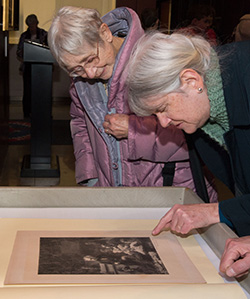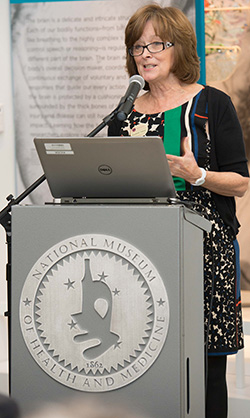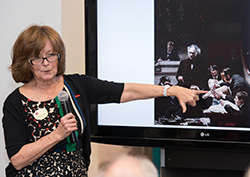Art Historian Presents Thomas Eakins' Portraits of Renowned Surgeons
By Lauren Bigge
NMHM Public Affairs Coordinator
Art professor Elizabeth Tebow, Ph.D., shared her knowledge of Thomas Eakins' 19th century portraits of renowned surgeons with a rapt audience at the National Museum of Health and Medicine's first 2017 Medical Museum Science Café, on Jan. 24. Tebow became a volunteer docent at NMHM in 2016.
Tebow, who has 40 years of experience teaching art history in the Washington, D.C. metropolitan area, first focused on a portrait in the NMHM's collection - that of John H. Brinton, the first NMHM curator. NMHM's founder, Surgeon General William Hammond, directed Brinton to collect medical specimens from the Civil War.
In its early years, the NMHM collected fine art portraits of museum founders as well as individuals important to the history of military medicine. The museum's art collections later evolved to document the expression of personal experiences by physicians, patients, and others who have contributed to or who have been affected by military medicine. NMHM's Otis Historical Archives cares for more than 100 works of fine art that were created as a means of artistic expression. Additionally, the collection houses more than 600 medical illustrations made for instructional purposes from the time of the Civil War through the present day.
"The portrait of Dr. Brinton by Thomas Eakins from 1876 is a very intimate kind of portrait," Tebow said. "He's sitting casually in a chair, surrounded by books and writing materials. Unlike other portraits of doctors, he's not holding any of the apparatus that he might have used as a doctor." NMHM's Eakins' portrait is on loan to the National Gallery of Art in Washington, D.C., where it is on display.
She explained that Philadelphia-born Eakins studied at the Pennsylvania Academy of Fine Arts and took anatomy classes at the Jefferson Medical College Hospital, before continuing his education in France and Spain.
Eakins returned to Philadelphia and submitted "The Gross Clinic" for the Centennial Exhibition of 1876, but it was initially rejected due to its graphic nature, deemed inappropriate for "squeamish audiences." The Philadelphia medical community, including Eakins' friends and Dr. Brinton, ensured that the portrait of Dr. Samuel Gross, chief of surgery at Jefferson Medical College, was displayed at the exposition. "This museum, now the National Museum of Health and Medicine, was responsible for organizing an exhibit at the exposition," she said. "It included a hospital. It had various vehicles – ambulances and the like. It had scale models of various types of facilities. And there was this wonderful painting by Thomas Eakins – The Gross Clinic." The painting shows Dr. Gross operating on a patient suffering from osteomyelitis, a diseased bone. Excising a bone, as Dr. Gross is seen doing, spared a patient from amputation.
"Dr. Gross is lecturing. There's a clerk taking down notes. You can see, in the shadows, various medical students. Eakins has included himself, with his arm resting on the railing," Tebow said. Assistants, appearing clinically detached, watch Dr. Gross as he holds a bloody scalpel. "There's a beautiful still-life of the medical instruments in the foreground. Eakins signed his name in the front of that. The painting is quite striking: Dr. Gross is in a beautiful aura of light, which emphasized his head. It's been suggested that Eakins was emphasizing the intellectual activity of the surgery by focusing light on the head of Dr. Gross."
"Eakins is clearly saying: surgery is an art," Tebow said.
In 1889, admirers of renowned surgeon David Hayes Agnew commissioned Eakins to paint a portrait of Agnew performing a mastectomy in a surgical arena, as a retirement gift. Tebow emphasized that the portrait documents how surgery had changed since "The Gross Clinic" had been completed in 1876: medical personnel are wearing white and showing concern about sepsis. "I can't think of any better example of an artist who valued science more than Thomas Eakins, and at the same time a scientist who valued art more than John Brinton," Tebow concluded.
The February Medical Museum Science Café – "The Air Force Medical Service: Building Competent, Capable Enlisted Airmen" – will be held Tues., Feb. 28, from 6-7 p.m., at NMHM, 2500 Linden Lane, Silver Spring, Maryland. CMSgt David J. Little, Headquarters Air Force, Chief of Medical Operations and Research, will highlight the essential ability for the Air Force Medical Service to technically and professionally develop our most precious resource in support of the United States Air Force and Joint Service missions. NMHM's Medical Museum Science Cafes are a regular series of informal talks that connect the mission of the Department of Defense museum with the public. NMHM was founded as the Army Medical Museum in 1862 and moved to its current location in Silver Spring, Maryland, in 2012. NMHM is an element of the Defense Health Agency. For more information on upcoming events, please call 301-319-3303 or visit www.medicalmuseum.mil.

|
Caption:
Two visitors examine a lithograph of Thomas Eakins' masterpiece painting, "The Gross Clinic," which features famed pathologist and surgeon, Dr. Samuel Gross (the lithograph is inscribed by Eakins to Dr. Joseph Leidy) on temporary display during the January 24, 2017 Medical Museum Science Café titled "The Art of Medicine: Portraits of Surgeons by Thomas Eakins" at the National Museum of Health and Medicine in Silver Spring, Md. The science café featured local art historian Elizabeth Tebow, Ph.D., who shared her findings about Eakins's portraits of noted 19th century physicians and surgeons. The NMHM archives contain several Eakins portraits, one of which is on loan to the National Gallery of Art in Washington, D.C.
(National Museum of Health and Medicine photo by Matthew Breitbart / Released) |

|
Caption:
Elizabeth Tebow, Ph.D., art historian and museum volunteer, speaks during the January 24, 2017 Medical Museum Science Café titled "The Art of Medicine: Portraits of Surgeons by Thomas Eakins" at the National Museum of Health and Medicine in Silver Spring, Md. Tebow shared her findings about Eakins's portraits of noted 19th century physicians and surgeons. The NMHM archives contain several Eakins portraits, one of which is on loan to the National Gallery of Art in Washington, D.C.
(National Museum of Health and Medicine photo by Matthew Breitbart / Released) |

|
Caption:
Elizabeth Tebow, Ph.D., art historian and museum volunteer, speaks during the January 24, 2017 Medical Museum Science Café titled "The Art of Medicine: Portraits of Surgeons by Thomas Eakins" at the National Museum of Health and Medicine in Silver Spring, Md. Tebow shared her findings about Eakins's portraits of noted 19th century physicians and surgeons. The NMHM archives contain several Eakins portraits, one of which is on loan to the National Gallery of Art in Washington, D.C.
(National Museum of Health and Medicine photo by Matthew Breitbart / Released) |

|
Caption:
Elizabeth Tebow, Ph.D., art historian and museum volunteer, speaks during the January 24, 2017 Medical Museum Science Café titled "The Art of Medicine: Portraits of Surgeons by Thomas Eakins" at the National Museum of Health and Medicine in Silver Spring, Md. Tebow shared her findings about Eakins's portraits of noted 19th century physicians and surgeons. The NMHM archives contain several Eakins portraits, one of which is on loan to the National Gallery of Art in Washington, D.C.
(National Museum of Health and Medicine photo by Matthew Breitbart / Released) |



